A decade ago, the sight of a non-white golf ball would raise a few eyebrows, but those days are long gone. TaylorMade, one of the largest golf ball makers in the world, predicts its non-white ball sales in 2024 – comprised of balls with stripes, special markings or customized logos – will eclipse traditional white ball sales for the first time.
Golf balls with corporate logos have been popular for decades, but tour pros like Rickie Fowler and Tommy Fleetwood compete in PGA Tour events, major championships and Ryder Cups using TaylorMade’s TP5 and TP5x Pix balls that have markings designed to aid in alignment and to reveal how purely you’ve hit your putt. Callaway’s Truvis balls, which are covered in pentagons, have been popular for several years and Srixon’s Divide balls are eye-catching in every weather condition and also help golfers perform better on the greens.
At the same time, manufacturers like Titleist, maker of the Pro V1, and Callaway, maker of the new Chrome Tour, have never made balls to a higher precisely, which means that from ball to ball, consistency is better than ever before.
With such a wide variety of balls on the market, ranging in price from about $22 to around $55 per dozen, finding a ball that matches your game and your budget can be tricky, but Golfweek’s 2024 Golf Ball Guide is here to help. Prioritize what you want from your golf ball (distance, short game spin, soft feel), and then think about a price range you are willing to pay. Keep in mind that if you go down in price, you will likely have to compromise something because the materials that make premium balls perform so well don’t come cheap.
Buy a three-ball sleeve of several different balls, go to the course and see how they perform on chip shots, pitch shots and short approach shots first, then see how they work for you with long irons and woods. The unique way you swing will make each ball play differently, but testing balls on the course will always be the best way to find your perfect golf ball.
Note: Golf balls are often released on two-year product cycles, which means updates are released every two years. For that reason, you will see several 2023 offerings alongside new 2024 putters.
